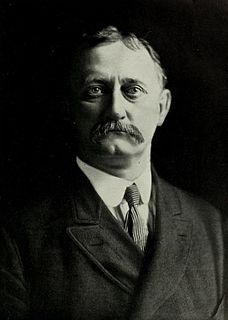| Type | Regional stock exchange |
|---|---|
| Location | St. Louis, Missouri, United States |
| Coordinates | Third Street between Olive and Locust |
| Founded | December 2, 1880 |
| Closed | 1893 |
| Currency | USD |
The St. Louis Mining and Stock Exchange was an American regional stock exchange. It formed in St. Louis, Missouri on December 2, 1880. It closed in 1893 during a financial depression.
The St. Louis Mining Exchange was formed in 1874. Location was described as the southeast corner of Fourth and Elm Streets. Founded by M. S. Mepham & Co as a headquarters for those engaged in mining or selling mineral lands. [1]
The St. Louis Mining and Stock Exchange was formed in St. Louis in the fall [1] of 1880, [2] [3] on Third Street between Olive and Locust Street. [3] The first meeting was held at its rooms at that location on December 2, 1880. on which day the exchange also opened for business at 11 am. [1]
Founding officers and directors included James Baker, Thomas Richeson, G. W. Chadbourne, Charles F. Orthwein, J. W. Paramore, John W. Noble, David R. Francis, and W. R. Allen. [1] [3] Between 1885 and 1890, there was a high level of investment in mining shares, and mining business did well in St. Louis. [3] It was organized under the laws of Missouri with all stock owned by men of St. Louis. With James Baker as president, the 1882 board included Chadbourne, Noble, Allen, Orthwein, Baker, Richeson, Paramore, and others such as D. P. Roland, D. R. Francis, Frank T. Iglehart, E. S. Chester, Jon E. Ennis, and T. W. Herman. [2] It closed in the depression of 1893. [4]
The Long Depression was a worldwide price and economic recession, beginning in 1873 and running either through March 1879, or 1896, depending on the metrics used. It was most severe in Europe and the United States, which had been experiencing strong economic growth fueled by the Second Industrial Revolution in the decade following the American Civil War. The episode was labeled the "Great Depression" at the time, and it held that designation until the Great Depression of the 1930s. Though a period of general deflation and a general contraction, it did not have the severe economic retrogression of the Great Depression.

John Willock Noble was a U.S. lawyer and brevet brigadier general in the Civil War. He served as the Secretary of the Interior between 1889 and 1893.

David Rowland Francis was an American politician and diplomat. He served in various positions including Mayor of St. Louis, the 27th Governor of Missouri, and United States Secretary of the Interior. He was the U.S. Ambassador to Russia between 1916 and 1917, during the Russian Revolution of 1917. He was a Wilsonian Democrat.

Peabody & Stearns was a premier architectural firm in the Eastern United States in the late 19th century and early 20th century. Based in Boston, Massachusetts, the firm consisted of Robert Swain Peabody (1845–1917) and John Goddard Stearns Jr. (1843–1917). The firm worked on in a variety of designs but is closely associated with shingle style.

Caleres Inc. is an American footwear company that owns and operates a variety of footwear brands. Its headquarters is located in Clayton, Missouri, a suburb of St. Louis. Founded in 1878 as Bryan, Brown & Company in St. Louis, it underwent several name changes; for a time, the Hamilton-Brown Shoe Company was the largest manufacturer of shoes in America. It went bankrupt in June 1939.

The Diamond Match Company has its roots in several nineteenth century companies. In the early 1850s, Edward Tatnall of Wilmington, Delaware was given an English recipe for making matches by a business acquaintance, William R. Smith. In 1853, Tatnall attempted to turn the recipe into a business at Market Street Bridge over Brandywine Creek in Wilmington. The first matches ignited with the slightest friction, a problem Tatnall solved by reducing the phosphorus content by 25 percent.

Grant Locomotive Works was a manufacturer of steam railway locomotives from 1867 to 1895, first in Paterson, New Jersey, and then in Chicago. The company built about 1,888 locomotives.
Frank C. Rand was an American businessman and philanthropist. He served as the President of the International Shoe Company, the world's largest shoe manufacturer, from 1916 to 1930, and as its Chairman from 1930 to 1949.
William R. Orthwein Jr. (1917–2011) was an American businessman and philanthropist.

The Orthwein Mansion is a historic mansion in St. Louis, Missouri, in the United States. It sits at 15 Portland Place, near the northeastern corner of Forest Park.
William David Orthwein (1841–1925) was a German-born American Civil War veteran and grain merchant in St. Louis, Missouri.
Adolphus Busch Orthwein, also known as Dolph Orthwein, (1917–2013) was an American heir and business executive.
Charles F. Orthwein (1839–1898) was a German-born American businessman from St. Louis, Missouri.
Ida Wikoff Baker was an American business executive, civic leader and philanthropist during the early 20th century whose legacy remains evident in 21st-century Decatur, Illinois. She and her sister, Laura B. Wikoff Pahmeyer (1855-1933), played key roles in the cultural and scientific growth of their community while also helping to advance women's rights during the late 1800s and early to mid-1900s through their development of financial support services for women.